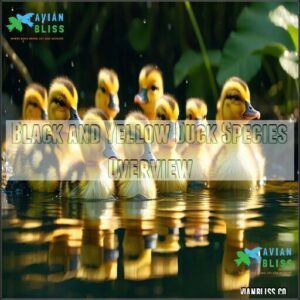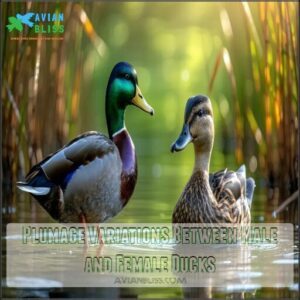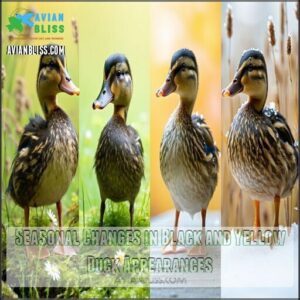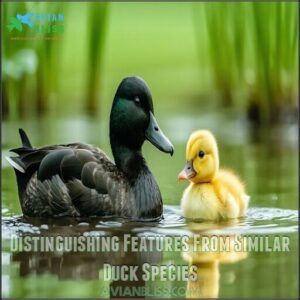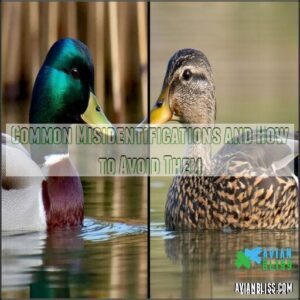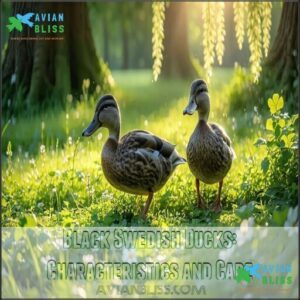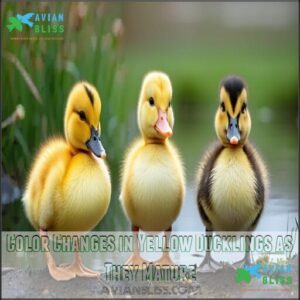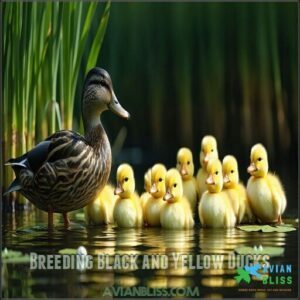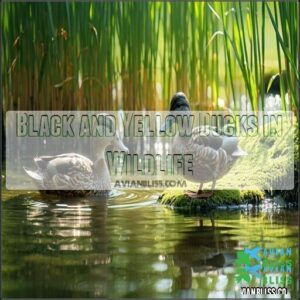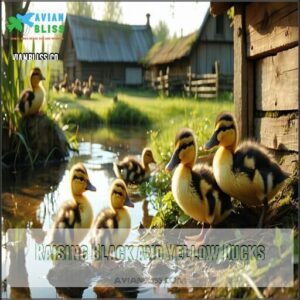This site is supported by our readers. We may earn a commission, at no cost to you, if you purchase through links.

You’ll often see species like the striking Black Swedish or black and yellow streaks on various ducklings before they mature.
These ducks thrive in wetland habitats, where they forage for insects, plants, and small fish.
Their coloration varies by age, gender, and sometimes the season, making them fun to identify.
If you’ve spied a yellow duckling turning darker, it’s likely just growing up!
Curious about care, breeding, or spotting them in the wild? Stick around—these feathered beauties have a lot more up their wings (metaphorically speaking)!
Table Of Contents
- Key Takeaways
- Black and Yellow Duck Species Overview
- Identifying Black and Yellow Ducks
- Black Swedish Ducks: Characteristics and Care
- Origin and History of Black Swedish Ducks
- Physical Attributes of Black Swedish Ducks
- Temperament and Behavior of Black Swedish Ducks
- Housing Requirements for Black Swedish Ducks
- Feeding and Nutrition for Black Swedish Ducks
- Health Concerns Specific to Black Swedish Ducks
- Breeding and Egg Production of Black Swedish Ducks
- Yellow Ducklings: Development and Transformation
- Breeding Black and Yellow Ducks
- Black and Yellow Ducks in Wildlife
- Raising Black and Yellow Ducks
- Frequently Asked Questions (FAQs)
- What does a black duck look like?
- Are all ducklings yellow?
- Which duck breeds have yellow offspring?
- Do ducks have black and yellow feathers?
- What does a blue duck look like?
- Are there black and white ducks in North America?
- How do I tell what breed of duckling I have?
- What are the black ducks with yellow bills?
- Are Cayuga ducks all black?
- What does a yellow duckling look like?
- Conclusion
Key Takeaways
- You’ll find black and yellow ducks in wetlands, thriving on a mix of insects, plants, and small fish while relying on their bold contrasting plumage for camouflage and mating displays.
- Watch yellow ducklings transform as they age, with their fluffy yellow down giving way to striking adult feathers depending on diet, breed, and environment.
- Ducks like the Black Swedish, Cayuga, and Magpie offer distinctive traits like glossy black feathers, unique bibs, or tuxedo-like patterns, making them popular choices for bird enthusiasts.
- Proper duck care involves balanced nutrition, predator-proof housing, and regular health checks to ensure they thrive in your backyard or farm.
Black and Yellow Duck Species Overview
In the case of black and yellow ducks, you’ll find a surprising variety of species with fascinating traits.
From ducklings decked out in cheerful yellow and black patterns to adults boasting striking black plumage, these waterfowl offer unique identification challenges and insights into nature’s design.
Ducklings sparkle with yellow and black down, growing into adults flaunting black feathers—a stunning tribute to nature’s creativity.
Common Black and Yellow Duck Breeds
Regarding black and yellow ducks, nature sure knows how to show off! These eye-catching birdies bring personality and charm to any backyard pond.
Let’s explore three amazing duck breeds that stand out for their distinctive coloring and features:
- Black Swedish Ducks – These ducks rock a tuxedo-like look. Their glossy black feathers shine with hints of emerald in sunlight, perfectly paired with a white bib for striking contrast.
- Cayuga Ducks – Known for their mesmerizing beetle-black feathers, they shimmer in rainbow hues under the light. Their unique Cayuga iridescence adds a magical touch to any pond.
- Magpie Ducks – These charmers start as yellow ducklings scattered with black markings. As adults, their Magpie patterns become bold black-and-white splashes.
Perfect for novices, these breeds combine beauty with easy-going temperaments!
Distinctive Features of Black and Yellow Ducks
You’ve learned about common breeds, but let’s explore what makes black and yellow ducks stand out.
First, their plumage patterns are striking.
Black ducks often flaunt rich, glossy feathers with bold accents, while yellow ducks display soft, golden hues that seem to glow.
These distinctive coloration traits help each species blend into their habitats or dazzle potential mates.
Look at their beak coloration too—male black ducks usually sport yellow-green bills, while females lean toward muted greens.
Yellow ducks, on the other hand, have cheerful orange-bordered bills.
Even their foot morphology is unique.
Darker, sturdy feet on black ducks power through deep waters, while lighter feet in yellow ducks are perfect for dabbling.
Oh, and their vocalizations?
Each species quacks with its own “accent,” truly making them one-of-a-kind!
Geographic Distribution of Black and Yellow Ducks
Black and yellow ducks thrive across varied landscapes, showing off their adaptability.
In North America, black ducks dominate wetlands, while yellow duck species stand out along coastal regions worldwide.
These birds are seasoned travelers, with migration routes spanning thousands of miles.
Their journeys connect habitats from Canada’s marshy lowlands to Africa’s warm wetlands.
But here’s the catch: shrinking duck habitats and climate impacts are hitting these birds hard.
Habitat variations once essential for survival are becoming scarce, disrupting migration patterns and affecting population density.
While these ducks still brighten ecosystems, duck populations need conservation efforts to safeguard future generations enjoy their lively presence across the Northern Hemisphere and beyond, ensuring the longevity of these species and maintaining biodiversity.
Habitat Preferences for Black and Yellow Ducks
Black and yellow ducks are picky about where they call home, and honestly, who can blame them? They look for habitats that meet their unique needs, blending safety and food supply.
You’ll spot these duck species in areas like:
- Wetland habitats packed with lush vegetation for nesting and hiding.
- Freshwater sources such as calm lakes, ponds, or streams, perfect for dabbling and diving.
- Coastal regions with sheltered coves and gentle waters.
- Seasonal wetlands teeming with insects and plants during breeding seasons.
- Quiet ecosystems with little human interference.
These ducks, like expert travelers, follow specific migration patterns to locate these ideal duck habitats.
Access to rich vegetation isn’t just a bonus—it’s essential for survival. Places with water and greenery offer the perfect mix of buffet and bedroom for black and yellow ducks.
Behavioral Characteristics of Black and Yellow Ducks
Spotting black and yellow ducks in action can feel like watching nature’s choreographed show.
You’ll notice their social interactions are all about teamwork.
Groups form tight bonds, working together during foraging or against threats.
Imagine them dabbling in shallow water like synchronized swimmers or diving underwater with precision.
Their feeding habits aren’t just effective but fascinating to watch.
During mating rituals, males turn on the charm by performing head bobs, flapping wings, or letting out extra-unique vocalizations.
It’s like a splashy bird competition, each trying to impress.
Activity patterns show both energy and caution.
When facing predators, their instinctive unity shines.
They’ll form dense groups and launch into flight like a perfectly-timed flock explosion—safety in numbers is their motto.
Duck behavior even involves "language."
Different sounds and body movements keep communication clear.
These diverse patterns, paired with duckling color patterns, make understanding black and yellow ducks endlessly exciting.
Conservation Status of Black and Yellow Duck Species
Wetland habitats, the lifelines for black and yellow ducks, are disappearing fast, leaving many species struggling.
It’s not just beautiful plumage at stake—it’s survival.
- Habitat Loss: Wetlands, essential for breeding, have shrunk by nearly 50% in some areas.
- Climate Impacts: Warming disrupts migration and food cycles, leaving ducks lost and hungry.
- Pollution Pressure: Runoff poisons water, damaging eggs and threatening ducklings before they even quack.
Duck conservation efforts, like wetland restoration and breeding programs, are stepping in to help species like Black Swedish Ducks.
You can pitch in too—support conservation organizations and track sightings to aid ongoing programs!
Identifying Black and Yellow Ducks
You can identify black and yellow ducks by observing their unique plumage patterns, beak shapes, and sizes.
Pay close attention to how their colors change with age and season, as these shifts often reveal their breed and natural adaptations.
Key Physical Characteristics for Identification
To spot black and yellow ducks, pay close attention to their physical traits.
Plumage patterns like iridescent feathers or bold markings can tell you a lot—Wood Ducks, for instance, have shiny plumage that stands out.
Study beak morphology, too.
Ducks with broad bills, like Mallards, dabble along water surfaces, while pointed beaks suggest diving habits.
Foot coloration also gives hints.
Sturdy, darker feet usually mean a diving duck, while lighter webbing is common among dabblers.
Even vocalizations may help as distinct quack patterns can reveal species when plumage isn’t clear.
Learning these duck characteristics sharpens your skills for better identification.
Duck colors may vary, but these subtle clues help reveal their secrets.
Plumage Variations Between Male and Female Ducks
When identifying ducks, keep an eye out for sexual dimorphism in their plumage.
Males often steal the show with eye-catching feather colors, shimmering iridescent patches, and distinct duck feather patterns, especially during mating displays.
Females, however, sport muted tones—like brown or gray—designed for camouflage while nesting.
This isn’t just about looks; it’s nature using coloration purpose to balance mating attraction with survival.
You’ll also notice variations in bill brightness or molting differences influenced by genetic factors that emphasize males’ beauty and females’ adaptability.
It’s biology working with flair!
Seasonal Changes in Black and Yellow Duck Appearances
Black and yellow ducks change their looks with the seasons, like a living wardrobe update.
These shifts in duck plumage are all about survival and social life:
- Breeding Colors: Males flaunt brighter yellow patches and bold black feathers to charm potential mates when nesting season begins.
- Plumage Molting: In summer, ducks shed old feathers, replacing them with duller tones that help them hide while flightless.
- Winter Camouflage: As the cold sets in, their feathers adapt to match muted, seasonal landscapes, balancing stealth and warmth.
It’s like watching nature’s fashion show, driven by biology!
Distinguishing Features From Similar Duck Species
Figuring out the differences between black and yellow ducks? It’s a bit like solving a wildlife puzzle. Ducks may look alike, but details can help you nail the ID.
Pay attention to these traits:
- Plumage Patterns: Look for glossy black feathers or subtle markings on yellow ducklings.
- Beak Morphology: Is it flat, slender, or broad? Shape matters.
- Vocalizations: Each species has a unique “quack accent.”
- Size Differences: Pintails are slim, whereas mallards are stocky.
- Habitat Overlap: Check where you spot them—wetlands or coasts?
Each clue uncovers a duck breed’s story. With these tips, duck breed identification becomes a rewarding adventure. Think sharp, and happy birding!
Tools and Techniques for Accurate Duck Identification
Recognizing black and yellow ducks is a bit like solving a nature puzzle – you need good tools and sharp observation. Start with binoculars (8×42 magnification works wonders) to notice tiny details, like plumage shading or beak morphology.
While checking for unique traits, remember that even subtle differences can confirm the breed. A solid identification guide, such as Sibley’s or Merlin Bird ID, will help you match physical characteristics like vocalizations or feather patterns.
If you’re out in the field, take notes—details like habitat cues or contrasting yellow-black plumage can make identification easier later. Want an extra edge? Use your smartphone to record duck sounds or snap photos.
These act as handy references when distinguishing hybrids or rare species. Even a plain notebook proves invaluable for tracking sightings, like interesting bill shapes or the evolution of yellow ducklings into distinct adult forms.
Common Misidentifications and How to Avoid Them
Spotting black and yellow ducks can be tricky, especially when similar species look almost alike.
Misidentifications happen, but a keen eye helps.
A few common mix-ups include:
- Female Mallards vs. Mottled or Black Ducks (check wing speculum in flight).
- Eclipse-plumage males mimicking females (bill colors often give clues).
- Domestic ducks resembling wild ones (size and stance hint at the difference).
- Black Swedish ducks vs. American Black Ducks (note unique bill markings).
Pay attention to behavior clues—dabbling ducks tip forward, while divers vanish underwater.
Location matters, too, as habitat often narrows species.
Duck colors change by season, so keep observing—patience always pays off!
Black Swedish Ducks: Characteristics and Care
Black Swedish ducks are hardy, medium-sized birds with shiny black plumage, a distinctive white bib, and calm, friendly temperaments.
They’re easy to care for, needing a clean coop, fresh water, and balanced feed to thrive.
Origin and History of Black Swedish Ducks
The story of the Black Swedish Duck begins in the 1800s, originating in the Swedish Pomeranian region.
This duck breed’s origins link to the Swedish Blue Duck, with careful early breeders focusing on their striking black plumage.
Historical records first documented them in 1835, highlighting their growing popularity.
When they arrived in America in 1884, these hardy ducks gained fans fast.
Their breed development balanced beauty and practicality, cementing their spot in farms.
By 1904, they earned official recognition from the American Poultry Association.
Black Swedish ducklings represent a legacy of heritage in duck breed characteristics and farming history.
Physical Attributes of Black Swedish Ducks
Black Swedish Ducks stand out as one of the most elegant black ducks.
Their plumage details include deep black feathers with a green shimmer under sunlight, sure to catch your eye.
Each duck flaunts a distinctive white bib size, resembling formal wear.
Physically, their body size is medium-large, averaging 6-8 pounds, with a graceful horizontal stance.
You’ll notice their bright orange bill color adds a charming contrast, while strong leg color—orange with black webbing—ensures excellent swimming.
This duck breed is as beautiful as it’s practical!
Temperament and Behavior of Black Swedish Ducks
Known for their calm yet curious personalities, Swedish Blue ducks thrive in flocks due to their low aggression levels and intricate social hierarchy.
They’re active foragers, exploring with gusto, and their adaptability makes them great for any setup.
You’ll enjoy their soft vocalizations and quirky head-bobbing.
Drakes charm with playful water displays, while females exhibit moderate broodiness.
| Trait | Description | Example Behavior |
|---|---|---|
| Social Hierarchy | Calm, group-oriented ducks | Peaceful flock interaction |
| Foraging Behavior | Active roamers, love exploring | Searching for small bugs |
| Vocalizations | Soft, pleasant sounds | Gentle quacks and murmurs |
Housing Requirements for Black Swedish Ducks
In regards to housing Swedish Blue Ducks, getting their setup right guarantees these black-feathered beauties stay healthy and lively. Their duck enclosure should offer at least 10-15 square feet per bird, giving them plenty of personal space. Think of it as their tiny mansion—spacious, secure, and comfy.
Protecting your ducks from predators? A must. Use strong fencing, such as hardware cloth, standing 4 feet tall and buried 6-12 inches deep to stop digging pests.
Inside the duck coop, cozy nesting boxes lined with straw keep them happy—aim for one box per 3-4 ducks. Consider various fencing options to guarantee the best safety.
Don’t forget drainage. Ducks hate standing in soggy mud, so proper drainage is non-negotiable. Add a small pond, at least 3 feet in diameter, to satisfy their love for water.
For colder months, winter housing gives them shelter from freezing weather. It’s safety and comfort, all quacked up!
Feeding and Nutrition for Black Swedish Ducks
Feeding your Black Swedish ducks doesn’t have to be complicated.
Start with high-quality duck feed containing 16-20% protein, formulated to their growth stage.
Ducklings thrive on higher protein diets, while adults need more calcium, especially during laying seasons.
To keep things interesting, offer fresh greens, grains, and insects as tasty treats—think of it as their duck buffet!
Clean, fresh water is a must, as ducks use it to drink and wash their bills during meals.
Letting them forage daily keeps their digestive systems healthy and natural instincts sharp.
The Swedish Blue Duck’s diet should adjust with the seasons, so watch their needs.
Consider purchasing specialized Black Swedish feed for ideal nutrition.
A happy duck is a well-fed duck, and yours will thank you with charm!
Health Concerns Specific to Black Swedish Ducks
To keep your Black Swedish Ducks healthy, start by understanding their general hardiness. These ducks, like other black ducks, benefit from their strong duck genetics, making them resilient compared to many duck breeds.
However, they’re not entirely immune—Leg Weakness, Feather Problems, and Bumblefoot Risk can arise without proper care.
Prevent duck diseases by maintaining clean, dry housing with good ventilation. Parasite Control, such as checking for mites around feathers, is also key.
Nutritional deficiencies can lead to issues like Egg Binding, so provide a calcium-rich diet to laying females. One common ailment to watch for is bacterial infections of the feet.
Regular health checks help spot concerns early. Look for signs like limping, dull feathers, or swelling. With basic duck health practices, your Black Swedish Ducks will thrive effortlessly.
Breeding and Egg Production of Black Swedish Ducks
How do Swedish Black ducks stand out in breeding? Their consistency in egg production and genetics makes them a favorite among duck breeds.
Here are key points you’ll love:
- Egg Laying: Expect 100-150 medium eggs annually, with rich, high-quality yolks.
- Pair Selection: Match ducks carefully to enhance genetic traits, creating robust offspring.
- Incubation Methods: Maintain consistent warmth for 28 days to guarantee hatching success.
- Hatching Success: Healthy nutrition in parent ducks greatly improves outcomes.
Swedish Black ducks excel in reproduction with their vibrant black plumage and reliable traits. Their straightforward feeding and breeding needs make them a satisfying choice for enthusiasts looking for dependable duck breeding success.
Yellow Ducklings: Development and Transformation
You’ll find it fascinating how yellow ducklings transform as they grow, with their fluffy down replaced by sleek adult feathers.
This change isn’t just about looks—timing, diet, and breed all play a role in shaping their final plumage.
Stages of Yellow Duckling Growth
From the moment they hatch, yellow ducklings undergo incredible changes during their growth stages.
Their initial coloration starts as fluffy yellow down, eventually replaced through natural down development.
Here’s their growth timeline:
- Hatch Day (0-24 hours): Wobbly hatchlings dry into soft, golden puffballs.
- First Adventures (2-14 days): They explore, swim briefly, and begin social bonding.
- Growth Phase (2-8 weeks): Rapid size increase and noticeable maturity markers like wing growth.
- Feathering Out (5-8 weeks): Adult duckling feather colors emerge during the critical molting timeline.
Every stage reveals nature’s brilliance, shaped by their environment and dietary impact!
Color Changes in Yellow Ducklings as They Mature
At around three weeks, those yellow ducklings start looking a little different.
Tiny black flecks pop up on their fluff—a clear signal their feather journey has begun.
By week four, the molting process kicks in, and you’ll notice the down giving way to new feathers.
Around week five, the vibrant yellow begins fading to brown, white, or breed-specific patterns.
This colorful change isn’t just for looks—it plays a big role in camouflage changes and survival.
Understanding the duck’s molting cycle is key to predicting these changes.
The pigment sources in their diet and genetics also impact how duckling feather colors take shape.
Before you know it, your little fluffball transforms into a magnificent adult.
What a cool maturity timeline!
Factors Influencing Duckling Color Development
Your duckling’s color changes are influenced by a mix of nature and nurture.
Genetics decide the base colors, while environmental factors and diet add extra flair.
Here’s what shapes their plumage:
- Dietary Pigments: Foods rich in carotenoids brighten feathers.
- Genetic Influence: Breed determines patterns and color limits.
- Environmental Factors: Sunlight and water quality affect feather pigmentation.
- Molting Process: Feathers mature and replace over time.
- Age Progression: Colors darken as ducklings grow.
These key influences guarantee each duckling develops its unique beauty naturally!
Caring for Yellow Ducklings During Transformation
Caring for yellow ducklings during their transformation is all about balancing comfort and growth.
Start with a duckling diet rich in protein to fuel healthy feather and body development. Keep their brooder at 90°F in week one, lowering it by 5°F each week.
Offer shallow water dishes for dabbling—no swimming until their feathers waterproof. Keep an eye out for stress: panting, fatigue, or loss of appetite aren’t normal.
Socialization tips include keeping them with other ducklings to mimic natural flock life. Protect them from predators by securing housing with proper coverings and barriers.
Expected Timeline for Full Adult Plumage
Watching your fluffballs grow feathers is like seeing nature’s magic happen right in your backyard.
By 6-8 weeks, their down feathers start to make room for proper wing feathers. This is when the molting timeline kicks off.
Between 8-16 weeks, their first molt leads to body plumage emerging. By 16-20 weeks, you’ll notice color stability as their adult feathers settle in, revealing their breed variations.
During duckling maturation, environmental factors and diet influence healthy feather growth. Extra protein and clean water help smooth the process.
Keep an eye on their progress and make certain their diet matches their growing needs. Before you know it, your ducklings will rock their full adult plumage like champs, with a proper wing and healthy feather growth.
Variations in Yellow Duckling Transformations by Breed
As you explore the remarkable world of yellow ducklings, you’ll notice how their fluff evolves into unique adult plumage, showcasing fascinating duck breed variations.
Every breed has its own story of transformation, influenced by Breed Coloration, Diet Impact, Molting Stages, and even Genetic Influence.
- Pekin ducks famously shift from sunshine-yellow down to pure white feathers within 8 weeks.
- Call ducks retain hints of yellow in their short, plump frames.
- Black Swedish ducklings trade their yellow chest for black feathers with elegant white bibs.
- Magpie ducks begin yellow but develop quirky tuxedo-like patterns.
- Rouen ducklings mirror Mallards with brown tones and detailed markings.
Environmental Factors and nurturing enhance these dramatic transformations, making duckling development an exciting journey.
Breeding Black and Yellow Ducks
Breeding black and yellow ducks can be a rewarding process if you start with healthy pairs and understand their genetic traits.
With the right environment, proper care, and a bit of patience, you’ll help your ducks thrive and produce strong, colorful offspring.
Selecting Breeding Pairs for Desired Traits
Breeding ducks with bold black and yellow plumage is like crafting art with genetics.
Start by selecting pairs with strong Temperament Traits and striking Plumage Genetics. Aim for good health, high Egg Production, and balance aesthetics with practicality.
Use the table below to guide choices:
| Trait | Why It Matters | How to Select |
|---|---|---|
| Temperament Traits | Reduces stress | Choose calm, social birds |
| Plumage Genetics | Vibrant offspring | Bright, unique coloration |
| Conformation Standards | Physical soundness | Well-formed bodies and sturdy legs |
Thoughtful selective breeding supports Hybrid Vigor and creates thriving flocks!
Optimal Breeding Conditions for Black and Yellow Ducks
You’ve chosen your pairs—nice work! Now, let’s create a duck-friendly breeding haven.
Environmental factors are key to duck breeding success, so focus on comfort and natural instincts. Ducks need clean water and nutritious, protein-rich feed (16–20%) to stay healthy and fertile.
Keep your ducks happy with duck-approved conditions:
- Maintain 55–75°F (13–24°C) for ideal comfort.
- Provide pools deep enough for water mating rituals.
- Create cozy nesting spots with quality straw or hay.
- Offer 16+ hours of light daily to support breeding cycles.
- Reduce stress by keeping their space calm and quiet.
Think of it as a spa-like retreat for ducks! When paired with strong duck genetic factors and good ethical breeding practices, you’ll see better hatching success.
Egg Incubation and Hatching Processes
Properly incubating duck eggs is like setting the stage for nature’s magic show—it takes precision, patience, and a watchful eye.
Start by keeping the incubation temperature steady at 99.5°F and humidity levels between 55-60% for the first 25 days. Turn the eggs 3-5 times daily to avoid embryo sticking, and candling eggs helps you track development.
As hatching nears, lower the temperature to 98.5°F with humidity rising to 75-80%. When you see the external pip (the duckling cracking the shell), resist the urge to interfere—mother nature knows best!
Once they emerge, keep the incubator at 95°F during their first 24 hours for safe drying. With careful monitoring, your duck incubation journey ends with happy, fluffy arrivals.
Genetic Factors in Black and Yellow Duck Breeding
In the case of black and yellow ducks, their stunning plumage isn’t luck—it’s all in the genes! Duck genetics plays a key role in creating those eye-catching feather combinations.
Here’s the scoop:
- Black feathers get their bold color from melanin, while yellow hues rely on carotenoid pigment.
- Selective breeding helps enhance traits like vibrancy or unique patterns.
- Gene mutations can lead to surprises, like unexpected coloration or markings.
- Hybrid vigor improves genetic diversity, producing healthier ducklings.
Understanding color inheritance makes breeding a fun science experiment. Sometimes, nature throws you a curveball, but those surprises often turn out to be the most beautiful results!
Common Breeding Challenges and Solutions
Raising black and yellow ducks can make anyone feel like a genetics teacher juggling patience and persistence. Fertility issues often surface, especially if you’re chasing specific plumage patterns.
Duckling mortality jumps when parents lack proper nutrition, so a balanced diet is a lifesaver. Hatching problems? Check that your incubator’s temperature isn’t playing hide-and-seek.
Young ducks need time to mature—don’t mistake immaturity for infertility. To reduce nesting failures, offer cozy, safe spaces with premium bedding.
Hybridization risks arise with mixed species, so stick to the right pairs.
- Pro tip: Healthy parents lead to stronger hatchlings. Focus on nutrition and consistent care.
Ethical Considerations in Duck Breeding Practices
Breeding ducks ethically isn’t just about producing colorful feathers—it’s about doing right by the ducks.
You should focus on maintaining welfare standards and avoid Genetic Manipulation or extreme hybridization concerns that harm their health.
Here’s a quick guide to smarter practices:
| Consideration | Do This | Avoid This | Why It Matters |
|---|---|---|---|
| Health First | Select strong, vibrant ducks | Inbreeding | Supports healthy offspring |
| Natural Behaviors | Encourage foraging, swimming | Traits suppressing instincts | Respects natural duck habits |
| Culling Practices | Only remove sick or unfit ducks | Over-culling | Prevents unnecessary harm |
| Conservation Ethics | Preserve rare breeds | Over-commercial breeding | Supports biodiversity |
Well-maintained duck breeding conditions and thoughtful decisions today guarantee thriving flocks tomorrow.
Black and Yellow Ducks in Wildlife
You’ll find black and yellow ducks thriving in wetlands, coastal areas, and other watery habitats where food and shelter abound.
These ducks rely on their unique coloration for camouflage and mating, making them fascinating to observe in the wild.
Natural Habitats of Wild Black and Yellow Ducks
Many black and yellow ducks call wetlands home, depending on these diverse ecosystems for survival. Wetlands offer food, shelter, and migration stopovers, making them essential for duck wildlife habitats.
You’ll spot these ducks in nutrient-packed coastal areas, freshwater lakes, and seasonal wetlands that align with migration routes. These habitats provide safe spaces to feed, breed, and rest.
From lush marshlands to calm rivers, ducks thrive where water meets land. However, habitat threats, like urbanization and climate change, put these spaces at risk.
Hunting restrictions are key to stabilizing numbers. Conservation efforts are key to preserving duck natural habitats.
- Coastal areas with ample vegetation and predator protection
- Lakes and rivers for consistent food sources
- Seasonal wetlands supporting migration stops
- Marshlands rich in plants and insects
Feeding Habits and Diets in The Wild
Out in wetland ecosystems, black and yellow ducks put their foraging strategies to work with remarkable skill.
They adapt their duck diets and techniques to the season, using clever tricks to snatch up available food.
Here’s what fuels their wild duck diets:
- Aquatic insects – Protein-packed treats like larvae and water bugs.
- Vegetation – Leafy greens and algae that grow nearby.
- Seeds – Shoreline snacks from grasses and aquatic plants.
- Tiny creatures – Snails, small fish, and even mini crustaceans add variety.
Their dietary adaptations guarantee thriving, year-round survival.
Predators and Survival Strategies of Black and Yellow Ducks
Black and yellow ducks are survival pros. They’ve mastered blending in thanks to duckling camouflage and adult plumage that matches reeds and murky waters, keeping them hidden from hawks and foxes.
Their smarts don’t stop there—these ducks have a knack for outmaneuvering threats with clever duck predator avoidance strategies.
Here’s how they stay safe:
- Quick dives: They’ll vanish underwater to leave predators guessing.
- Smart flock behavior: They post “lookouts” while others feed.
- Strategic nests: Hidden deep in vegetation, their nesting spots guarantee privacy and quick escape paths.
Combine these tricks with their ability to choose safe habitats, and you’ve got nature’s ultimate survivors!
Migration Patterns of Black and Yellow Duck Species
Duck migration is like nature’s road trip, guided by instinct and precision.
Black ducks often travel the Atlantic Flyway, while mallards favor the Mississippi Flyway. These migration routes, or “highways in the sky,” are shaped by habitat connectivity and triggered by seasonal food availability and breeding needs.
Ducks navigate using visual landmarks, celestial cues, and even Earth’s magnetic field. Flock dynamics play a key role, with formations helping reduce fatigue over thousands of miles.
Understanding migration patterns supports better conservation strategies, ensuring these journeys continue despite growing climate impacts.
Impact of Climate Change on Black and Yellow Ducks
Climate change is shaking up life for black and yellow ducks, compelling them to adapt or face tougher odds.
Black and yellow ducks face shrinking wetlands and tougher migrations, pushing them to adapt in a rapidly changing world.
Rising sea levels and warmer temps are causing habitat loss, making their cozy wetlands vanish. Without these nesting sites, ducks are like house hunters without a map.
Shifts in migration changes push these birds to reroute, often leading to shorter migrations or overcrowding in new areas. It’s like showing up to a party where there’s not enough food to go around.
Speaking of food, availability issues add to the stress. Aquatic ecosystems are changing, leaving fewer tasty plants and critters for ducks to munch on.
Here’s how climate change affects them:
- Breeding success drops with extreme weather.
- Population decline follows competition for resources.
- Diseases rise in warmer waters.
Conservation Efforts for Wild Black and Yellow Ducks
Keeping black and yellow ducks around for future generations means safeguarding their homes and understanding how they live.
Habitat preservation plays the biggest role, with efforts to restore wetlands and protect nesting grounds.
Farmers and conservationists work together, ensuring duck migration patterns remain undisturbed, even as climate changes try to shuffle their paths.
Scientists track populations and study how duck climate change impact affects breeding and survival.
Duck conservation programs also focus on creating breeding programs to boost numbers where they’re struggling.
These efforts combine to keep duck conservation status stable, allowing these fascinating waterfowl to thrive in the wild.
Raising Black and Yellow Ducks
Caring for black and yellow ducks is both rewarding and manageable when you’ve got the right setup.
You’ll need to focus on proper enclosures, nutrition, and daily routines to keep them healthy and thriving.
Setting Up a Suitable Duck Enclosure
Creating a cozy home for your black and yellow ducks doesn’t have to ruffle your feathers. A well-thought-out duck enclosure design guarantees happy, healthy birds.
- Enclosure Size: Allow at least 10 sq. ft. per duck. They’ll appreciate space to waddle, forage, and stretch.
- Predator Protection: Use 1/4-inch hardware cloth, buried 12 inches deep, to keep pesky predators out.
- Water Access: Provide a shallow pond or kiddie pool. Clean it daily to prevent illness—ducks are messy swimmers!
- Shelter Needs: Build snug boxes with straw bedding and shaded areas to shield them from harsh weather.
Think of your duck enclosure setup as their feathered castle—functional, secure, and comfy for quacks and waddles all day.
Daily Care Routine for Black and Yellow Ducks
Start your duck daily care by doing quick health checks—look for bright eyes, clean feathers, and active waddling.
Ducks thrive on routine! Stick to a solid feeding schedule: provide age-appropriate feed (starter for ducklings, layer for adults) and sprinkle in treats like greens or mealworms.
Water maintenance is essential—refresh drinking water daily and swimming water every other day.
Keep nesting box bedding clean and dry for comfy egg-laying. Many birds sport similar coloration.
Nutritional Requirements at Different Life Stages
As ducks grow, their nutritional needs shift like gears on a bike, helping them stay healthy and active.
Providing the right feed at every stage matters. Here’s a handy guide to duck life stage nutrition:
- Ducklings (0-3 weeks): Feed a high-protein (20-22%) duckling starter for rapid growth.
- Juveniles (3-16 weeks): Switch to a growing diet with 16-18% protein to support feather and body development.
- Adult layers: Offer 16-17% protein plus calcium for strong eggshells.
- Non-layers: Stick to adult maintenance feed with 14-16% protein.
- Seniors: Lower protein (13-15%) and add molting nutrients or joint supplements for comfort.
Balanced duck nutrition guarantees energy, healthy feathers, and happy quacks!
Health Monitoring and Common Duck Ailments
A healthy flock of black and yellow ducks starts with regular health checks. Look for signs like lethargy, poor appetite, or dull feathers, as these could signal common duck ailments.
Keep an eye out for wheezing (a red flag for respiratory infections), unusual droppings (possible parasites), or foot sores (bumblefoot). For respiratory infections, duck owners often seek antibiotics.
Duck Ailments Quick Guide
Respiratory issues: Wheezing? See a vet for antibiotics.
Parasite control: Deworm regularly, monitor droppings.
Injury management: Clean feet wounds promptly.
Clean coops, proper diets, and fresh water keep ducks thriving—prevention beats treatment every time!
Socialization and Flock Management Techniques
Black and yellow ducks thrive in a well-socialized flock. Each one plays a role in their small society, from natural leaders to followers.
For smooth duck flock management:
- Duckling integration takes patience—introduce them slowly using neutral spaces to keep peace.
- Provide enough space to avoid crowding and preventing aggression due to stress.
- Use multiple feeding stations to calm food-related squabbles.
These simple duck socialization techniques support harmony, stronger hierarchies, and healthier birds. Remember, happy ducks mean better egg production and livelier daily quacks!
Legal Considerations for Keeping Black and Yellow Ducks
Welcoming black and yellow ducks into your life isn’t just about quacks and feathers—it requires homework.
Before setting up the perfect coop, make certain you’re covering all your bases with these legal requirements:
- Local Ordinances and Zoning Regulations
Check if duck enclosures are permitted in your area. Some communities restrict livestock or require specific space standards.
- Permits and Animal Welfare Laws
Certain states demand duck permits, especially under the Migratory Bird Act, to protect species and maintain ethical standards.
- Liability and Noise Concerns
Obtain liability insurance for unforeseen issues. Also, keep those early-morning quacks in check to avoid neighbor disputes.
Staying informed guarantees your flock thrives happily—and legally!
Frequently Asked Questions (FAQs)
What does a black duck look like?
Picture a sleek, feathered swimmer with an all-black body and sometimes glossy or iridescent tones.
Often, they sport darker feet and a sharp, curved bill.
Some species add unique yellow or green accents, such as green accents.
Are all ducklings yellow?
Not all ducklings are yellow—it’s like nature’s way of mixing up the palette.
While breeds like Pekins sport yellow down, others, like Mallards, have darker patterns for camouflage.
Colors help protect and identify them, and it’s a way of nature’s mixing that aids in their survival.
Which duck breeds have yellow offspring?
Duck breeds with yellow offspring include Pekin, Call, Saxony, Magpie, Indian Runner, Mallard, and Muscovy ducks.
Not all yellow ducklings stay that way; many develop different colors as they mature, showcasing unique transformations.
Do ducks have black and yellow feathers?
Sometimes nature mixes it up.
Some duck breeds, like Black Muscovy or Cayuga, sport black feathers with yellow accents as ducklings but lose the yellow over time, leaving striking, mature black plumage behind.
What does a blue duck look like?
A blue duck typically has soft grayish-blue feathers with subtle brown or slate tones, complemented by a white patch near the bill.
It’s a rare bird often spotted around fast-flowing rivers and streams.
Are there black and white ducks in North America?
Spotting black and white ducks in North America is like finding a tuxedo at a beach party—unexpected but striking.
Look for species like Magpie Ducks or Buffleheads, known for their bold, contrasting plumage.
How do I tell what breed of duckling I have?
To identify your duckling’s breed, check its feather colors, patterns, and markings.
Observe size, beak shape, and behavior.
Compare these traits with known duck breeds, as many start yellow but develop distinct hues, and note that observing complete concepts is crucial for accurate identification.
What are the black ducks with yellow bills?
Black ducks with yellow bills often include species like the Cayuga, with their striking iridescent feathers, or American Black Ducks, boasting bold dark plumage.
The yellow adds an eye-catching contrast, perfect for identification!
Are Cayuga ducks all black?
Cayuga ducks are mostly black, but there’s more to them.
Their feathers shimmer with green and purple in sunlight, giving them a stunning, iridescent look.
They’re like walking rainbows dressed in sleek black suits!
What does a yellow duckling look like?
A yellow duckling looks like a fluffy little sunshine nugget, often with soft, golden plumage, a tiny orange beak, and webbed feet.
Some have dark spots or stripes that hint at their adult feather colors.
Conclusion
Like a puzzle coming together, black and yellow ducks combine striking colors, fascinating behaviors, and varied habitats.
Knowing their species, gender differences, and seasonal changes helps you identify them accurately, while caring for them involves balancing proper housing, diet, and health monitoring.
Whether you’re spotting wild ducks or raising Black Swedish breeds, these birds bring charm and curiosity to any setting.
Step into their world, and you’ll uncover the vibrant lives of black and yellow ducks, and discover the joy of understanding their fascinating behaviors.

